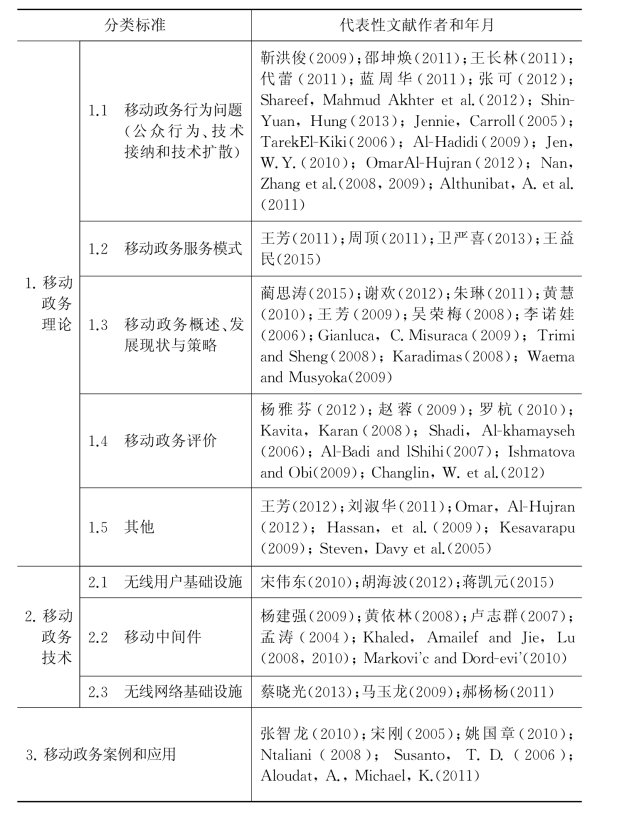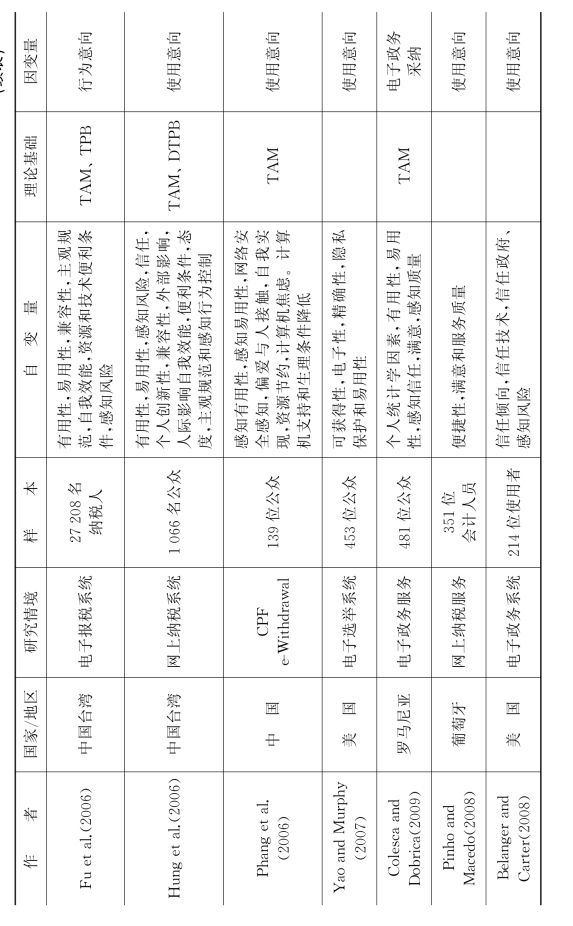前面的文献回顾主要是以IT采纳理论模型为主,本节主要论述当前国内外关于移动政务的研究现状。关于移动政务的研究文献是比较多的,为了能够对移动政务的研究现状进行系统梳理,本节借鉴Nagi对移动商务文献的分析框架分析移动政务研究现状[163],并且主要针对移动政务采纳研究现状和电子政务采纳研究进行了重点论述。
一、移动政务研究概况
现有文献内容涵盖极其广泛,为了能够对移动政务的研究有清晰的认知,本书借鉴Nagi(2007)对移动商务的分类将移动政务的研究分为以下三类:一是移动政务理论研究,具体包括移动政务行为问题(公众行为,技术接纳和技术扩散)、移动政务服务模式、移动政务概述、发展现状与策略、移动政务评价和其他方面的文献。二是移动政务技术研究,包括无线用户基础设施、无线中间件和无线网络基础设施。三是移动政务应用和案例研究。该分析框架包含移动政务五个层级的内容,分析框架图如2.11。

图2.11 移动政务研究文献分类框架
下面对五个层级内容进行详细论述:
(1)移动政务理论研究:该研究内容是分析框架中最低层级的部分,具体包括移动政务概述、发展现状与对策、移动政务评价、移动政务用户行为问题(公众行为、技术接纳和技术扩散)、移动政务服务模式和其他理论研究。
(2)无线网络基础设施:这是支撑移动政务发展和应用的关键技术,无线网络基础设施在移动政务实施应用中扮演着非常重要的角色,因为它是移动政务发展的关键核心技术。它提供无线网络和网络标准,如全球移动通信系统(GSM)、蓝牙、无线局域网络(WLAN)、无线电频率识别(RFID)、第三代网络技术(3G)等,探讨无线网络和网络标准的文献就被包含在“无线和移动网络”中。为了确保移动政务的应用和服务的可靠性和效率性,无线和移动网络的应用实施有必要考虑多种类的网络需求。“网络需求”包含移动政务的无线基础设施需求,例如位置管理、网络可靠性、服务质量等。
(3)移动中间件:移动中间件是连接不同的移动应用,程序和系统的一种软件,起着固网信息系统和手机的中间衔接作用。包含在该部分的文献主要分为代理技术、数据库管理、安全问题、无线和移动通信系统、无线和移动协议。
(4)无线用户基础设施:无线用户基础设施由硬件和软件两部分组成。软件是指操作系统和他们的接口,而硬件是指与移动政务应用沟通的移动设备,比如PDAs和移动手机。在分类框架中,移动接口和移动手持设备被包含在该部分。
(5)移动政务案例和应用:移动政务有很多不同的应用。根据黄慧(2010)对移动政务的应用分类[164],共包括三类具体应用:基于消息的服务(如短信息、彩信)、基于位置的服务(如人员追踪和车辆定位)、基于移动互联网的服务(如WAP、城管通和环保通)。除了移动政务应用外,本部分还包括一些国家或地区的移动政务案例。
下表列示了移动政务研究的代表性文献。
表2.15 移动政务研究现状分类和代表文献

二、移动政务采纳研究现状
一是从定性角度分析影响用户接受的主要因素。Tarek El-Kiki等(2006)将用户使用移动政务服务的目标分为物有所值、服务质量、有效的事务处理、战略数据、使用五类,并建立了终端用户服务需求的概念模型。[165]Omar Al-Hujran(2012)认为信任、公众意识、成本、基础设施限制和缺少法律机制是影响公众接受移动政务的主要因素。[166]代蕾(2011)以TAM和信息系统持续使用模型为理论基础,构建了移动电子政务的公众持续使用模型。[167]赵玉攀等(2015)基于TAM模型以实际使用替代使用意愿,构建了包括互动性、移动性、情景感、临界质量以及感知鼓励五个新变量的公众采纳政务APP的影响因素模型。[168]
二是用户接受移动政务服务的实证研究。可细分为两类:第一类是针对公众的研究(Shau-Jung Kuo,2008;Adam Vrechopoulos et al.,2009;Shareef,Mahmud Akhter,2012;Shin-Yuan Hung,2013,靳洪俊,2009;王长林,2011;张可,2012),例如:Shin-Yuan Hung等(2013)[169]以TPB为理论基础,构建了公众接纳移动政务的概念模型。Shareef,Mahmud Akhter等(2012)综合了TAM和IDT等理论,建立了移动政务的公众接受模型(CAB-MG)。[170]王长林(2011)以任务—技术匹配为理论基础,构建了移动政务用户的持续使用模型,分析影响用户对移动政务的持续使用行为。[171]张可(2012)从用户个人因素、外部环境因素、技术因素、任务因素和组织因素分析影响移动政务公众接受度。[172]第二类是针对公务员的研究,例如:Paul Jen-Hwa Hu等(2009)建立了执法人员接受COPLINK手机的概念模型,并通过对41名执法人员的调查进行检验。[173]
移动政务采纳研究文献偏少,可能不能够体现公共部门的IT采纳研究现状。因此,本书将电子政务采纳研究的文献整理如表2.16,有助于更加清晰地把握整个电子政务IT采纳的研究现状。
三、对现有研究的总体评价
通过以上对电子政务采纳研究文献的回顾,可以发现大部分研究都将公众的采纳行为嵌入不同的理论框架中,而这些理论源于不同的学科领域,如信息系统、社会心理学和心理学等。根据这些理论,研究者们从不同角度识别出影响公众采纳电子政务的诸多因素。不可否认,这些前期研究成果是对电子政务采纳研究的早期探索,但是离全面洞察的要求还存在相当的距离。一方面,一部分研究仅仅从一个单一的视角对电子政务采纳问题进行解释,如仅片面强调用户对电子政务系统的质量感知,从而忽略了其他影响因素。而基于经典IT采纳模型的研究,如有些研究以TAM为理论基础,这些研究侧重用户对使用系统的主观信念(感知有用性、感知易用性等),但并未指出电子政务那些特性因素影响用户对系统的使用感知。另一方面,一部分研究片面追求影响因素的广泛性,过于依赖经典IT采纳理论模型,将不同理论模型中的影响因素整合到一个理论框架中,这使得模型构建和因素识别上过于简单和紊乱。尽管研究者们不断地将新变量纳入各自的研究模型,如感知信任、感知收益、感知娱乐性等,但对因素之间关系的解释却过于牵强,实际上并未增加研究的理论价值,对实践者的启示意义也不明显。
表2.16 电子政务采纳研究文献

(续表)

(续表)

(续表)

在实证研究方面,样本的选择和样本量的大小成为电子政务公众采纳研究的主要限制。与电子商务不同,在电子商务环境下,商家可以选择他们在线提供服务的对象。而政府是公共服务的提供者,在提供电子化公共服务时针对的群体是所有公民,而且服务覆盖各行各业,对所有的服务对象都要一视同仁,包括低收入群体和残疾人士。因此,电子政务的用户应该包括所有公民。但由于各种条件的限制,现有实证研究很难实现将所有公民作为总体选取样本,很多研究是将一个城市为主要研究对象,采取方便抽样收集样本,这就大大限制了研究结果的普遍性。另外,还有少部分研究以特殊群体为抽样对象,如Teo等(2008)[174]针对政府网站用户的调查就选择了新加坡高校学生为样本,他们认为所选样本能够近似地符合新加坡电子政务用户的实际年龄范围。Phang等(2005)[175]则选取了新加坡50岁以上的老年人为样本。此外,现有研究在选择研究样本时,常常会假定用户已经在使用政务在线服务方面具有足够的能力和经验,大部分被测者都有一定的政府网站的使用经验,这往往忽视了相当数量的“潜在用户”。这些“潜在用户”对政府电子服务的使用经验较少,有些甚至从未访问过政府网站。本书认为,正是由于电子政务用户的普遍性,在调查对象的选取方面,在研究时我们更应该增加样本类型和容量,根据随机化原则保证样本既具有网络用户的代表性,又在公民总体中分布均匀。
本书关注的是电子政务发展方面的移动政务服务,现有对移动政务采纳的研究文献非常少。在少有的部分研究中,主要借鉴以往IT采纳理论模型进行研究,并没有针对移动政务的特殊方面进行情境化研究。为此,本书通过回顾以往理论和研究文献,构建一个mG2C情境的采纳模型,以期更好地理解移动政务用户的采纳行为。
【注释】
[1]Fishbein,M.,Ajzen,I.,Belief,attitude,intention and behavior:An introduction to theory and research,MA:Addison-Wesley,Reading,1975.
[2]Davis,F.D.,Perceived usefulness,perceived ease of use,and user acceptance of information technology,MIS quarterly,1989,13(3):319-340.
[3]Ajzen,I.,Madden,T.J.,Prediction of goal-directed behavior:Attitudes,intentions,and perceived behavioral control,Journal of experimental social psychology,1986,22(5):453-474.
[4]Madden,T.J.,Ellen,P.S.,Ajzen,I.,A comparison of the theory of planned behavior and the theory of reasoned action,Personality and social psychology Bulletin,1992,18(1):3-9.
[5]Fishbein,M.,Ajzen,I.,Belief,attitude,intention and behavior:An introduction to theory and research,MA:Addison-Wesley,Reading,1975.
[6]Ajzen,I.,The theory of planned behavior,Organizational behavior and human decision processes,1991,50(2):179-211.
[7]Ajzen,I.,Madden,T.J.,Prediction of goal-directed behavior:Attitudes,intentions,and perceived behavioral control,Journal of experimental social psychology,1986,22(5):453-474.
[8]Eagly,A.H.,Chaiken,S.,The psychology of attitudes,Harcourt Brace Jovanovich College Publishers,1993.
[9]Foxall,G.R.,Marketing psychology:The paradigm in the wings,Palgrave Macmillan,1997.
[10]Ajzen,I.,The theory of planned behavior,Organizational behavior and human decision processes,1991,50(2):179-211.
[11]Parker,D.,Manstead,A.S.R.,Stradling,S.G.,Extending the theory of planned behaviour:The role of personal norm,British Journal of Social Psychology,1995,34(2):127-138.
[12]Davis,F.D.,Perceived usefulness,perceived ease of use,and user acceptance of information technology,MIS quarterly,1989,13(3):319-340.
[13]Venkatesh,V.,Davis,F.D.,A theoretical extension of the technology acceptance model:four longitudinal field studies,Management science,2000,46(2):186-204.
[14]Agarwal,R.,Prasad,J.,Are individual differences germane to the acceptance of new information technologies?,Decision sciences,1999,30(2):361-391.
[15]Adams,D.A.,Nelson,R.R.,Todd,P.A.,Perceived usefulness,ease of use,and usage of information technology:a replication,MIS quarterly,1992:227-247.
[16]Igbaria,M.,Iivari,J.,Maragahh,H.,Why do individuals use computer technology?A Finnish case study,Information&Management,1995,29(5):227-238.
[17]Szajna,B.,Software evaluation and choice:predictive validation of the technology acceptance instrument,MIS quarterly,1994:319-324.
[18]Mathieson,K.,Predicting user intentions:comparing the technology acceptance model with the theory of planned behavior,Information systems research,1991,2(3):173-191.
[19]Lee,Y.,Kozar,K.A.,Larsen,K.R.T.,The technology acceptance model:past,present,and future,Communications of the Association for Information Systems,2003,12(1):50.
[20]Agarwal,R.,Karahanna,E.,Time flies when you're having fun:cognitive absorption and beliefs about information technology usage 1,MIS quarterly,2000,24(4):665-694.
[21]Taylor,S.,Todd,P.A.,Understanding information technology usage:A test of competing models,Information systems research,1995,6(2):144-176.
[22]Mathieson,K.,Predicting user intentions:comparing the technology acceptance model with the theory of planned behavior,Information systems research,1991,2(3):173-191.
[23]Rogers,E.M.,Diffusion of innovations,5th edn,New York:Free Press,2003.
[24]Rogers,E.M.,Diffusion of innovations,5th edn,New York:Free Press,2003.
[25]Moore,G.C.,Benbasat,I.,Development of an instrument to measure the perceptions of
adopt
ing an information technology innovation,Information systems research,1991,2(3):192-222.
[26]Moore,G.C.,Benbasat,I.,Development of an instrument to measure the perceptions of adopting an information technology innovation,Information systems research,1991,2(3):192-222.
[27]Thompson,R.L.,Higgins,C.A.,Howell,J.M.,Personal computing:toward a conceptual
[28]Moore,G.C.,Benbasat,I.,Development of an instrument to measure the perceptions of adopting an information technology innovation,Information systems research,1991,2(3):192-222.
[29]Bandura,A.,Self-efficacy mechanism in human agency,American psychologist,1982,37(2):122.
[30]Bandura,A.,Self-efficacy:Toward a Unifying Theory of Behavioral Change,Psychological Review,1977,84(2):191-215.
[31]Gist,M.E.,Self-efficacy:Implications for organizational behavior and human resource management,Academy of management review,1987,12(3):472-485.
[32]Gist,M.E.,Mitchell,T.R.,Self-efficacy:A theoretical analysis of its determinants and malleability,Academy of management review,1992,17(2):183-211.
[33]Marakas,G.M.,Mun,Y.Y.,Johnson,R.D.,The multilevel and multifaceted character of computer self-efficacy:Toward clarification of the construct and an integrative framework for research,Information systems research,1998,9(2):126-163.
[34]Compeau,D.R.,Higgins,C.A.,Computer self-efficacy:Development of a measure and initial test,MIS quarterly,1995:189-211.
[35]Venkatesh,V.,Creation of favorable user perceptions:exploring the role of intrinsic motivation,MIS quarterly,1999:239-260.
[36]Davis,F.D.,Bagozzi,R.P.,Warshaw,P.R.,Extrinsic and intrinsic motivation to use computers in the workplace,Journal of applied social psychology,1992,22(14):1111-1132.
[37]Triandis,H.C.,Interpersonal Behavior,CA:Brooke/Cole,Monterey,1977.
[38]Thompson,R.L.,Higgins,C.A.,Howell,J.M.,Personal computing:toward a conceptual model of utilization,MIS Quarterly,1991,15(1):125-143.
[39]Davis,F.D.,Perceived usefulness,perceived ease of use,and user acceptance of information technology,MIS quarterly,1989,13(3):319-340.
[40]Venkatesh,V.,Davis,F.D.,A theoretical extension of the technology acceptance model:four longitudinal field studies,Management science,2000,46(2):186-204.
[41]Venkatesh,V.,Morris,M.G.,Davis,G.B.et al.,User acceptance of information technology:toward a unified view,MIS Quarterly,2003,27(3):425-478.
[42]Venkatesh,V.,Morris,M.G.,Davis,G.B.et al.,User acceptance of information technology:toward a unified view,MIS Quarterly,2003,27(3):425-478.
[43]Koivumäki,T.,Ristola,A.,Kesti,M.,The perceptions towards mobile services:an empirical analysis of the role of use facilitators,Personal and Ubiquitous Computing,2008,12(1):67-75.
[44]Eckhardt,A.,Laumer,S.,Weitzel,T.,Who influences whom?Analyzing workplace referents'social influence on IT adoption and non-adoption,Journal of Information Technology,2009,24(1):11-24.
[45]Curtis,L.,Edwards,C.,Fraser,K.L.et al.,Adoption of social media for public relations by nonprofit organizations,Public Relations Review,2010,36(1):90-92.
[46]Verhoeven,J.C.,Heerwegh,D.,De,Wit,K.,Information and communication technologies in the life of university freshmen:An analysis of change,Computers&Education,2010,55(1):53-66.
[47]Wang,Y.S.,Wu,M.C.,Wang,H.Y.,Investigating the determinants and age and gender differences in the acceptance of mobile learning,British Journal of Educational Technology,2009,40(1):92-118.
[48]Wang,H.Y.,Wang,S.H.,User acceptance of mobile internet based on the Unified Theory of Acceptance and Use of Technology:Investigating the determinants and gender differences,Social Behavior and Personality,2010,38(3):415-426.
[49]朱红灿、廖小巧:《基于UTAUT的公众政府信息获取网络渠道使用意愿模型研究》,《情报杂志》2016年第8期,第204—207页。
[50]Bagozzi,R.P.,The Legacy of the Technology Acceptance Model and a Proposal for a Paradigm Shift,Journal of the association for information systems,2007,8(4):244-254.
[51]Oliver,R.L.,A Cognitive Model of the Antecedents and Consequences of Satisfaction Decisions,Journal of Marketing Research,1980,17(4):460-469.
[52]Anderson,E.W.,Sullivan,M.W.,The Antecedents and Consequences of Customer Satisfaction for Firms,Marketing Science,1993,12(2):125-143.
[53]Kelley,H.H.,Thibaut,J.W.,Interpersonal relations:A theory of interdependence,New York:Wiley,1978.
[54]Fukuyama,F.,Trust:The social virtues and the creation of prosperity,New York:Free Press,1995.
[55]Luhmann,N.,Trust and Power,London:John Wiley,1979.
[56]Kim,K.K.,Prabhakar,B.,Initial trust and the adoption of B2C e-commerce:The case of internet banking,ACM sigmis database,2004,35(2):50-64.
[57]鲁耀斌等:《移动商务的应用模式与采纳研究》,科学出版社2008年版。
[58]Lee,M.K.O.,Turban,E.,A Trust Model for Consumer Internet Shopping,International Journal of Electronic Commerce,2001,6(1):75-91.
[59]Jarvenpaa,S.L.,Tractinsky,N.,Vitale,M.,Consumer trust in an Internet store,Information Technology and Management,2000,1(1):45-71.
[60]Carter,L.,Bélanger,F.,The utilization of e-government services:citizen trust,innovation and acceptance factors,Information Systems Journal,2005,15(1):5-25.
[61]费军等:《国家治理现代化背景下“互联网+政务”思维与路径策略性研究》,《电子政务》2016年第8期,第111—118页。
[62]Deutsch,M.,Trust and suspicion,The Journal of conflict resolution,1958,2(4):265-279.
[63]Rotter,J.B.,Generalized expectancies for interpersonal trust,American Psychologist,1971,26(5):443-452.
[64]Luhmann,N.,Trust and Power,London:John Wiley,1979.
[65]Bradach,J.L.,Eccles,R.G.,Price,Authority,and Trust:From Ideal Types to Plural Forms,Annual Review of Sociology,1989,15(1):97-118.
[66]Bromiley,P.,Cummings,L.L.,Transactions costsin organizations with trust,Research on negotiation in organizations,1995,5:219-250.
[67]Humphrey,J.,Schmitz,H.,Trust and economic development,Institute of Development Studies,1996.
[68]Fukuyama,F.,Trust:The social virtues and the creation of prosperity,New York:Free Press,1995.
[69]Anderson,J.C.,Narus,J.A.,A model of distributor firm and manufacturer firm working partnerships,the Journal of Marketing,1990,54(1):42-58.
[70]Doney,P.M.,Cannon,J.P.,An examination of the nature of trust in buyer-seller relationships,the Journal of Marketing,1997,61(2):35-51.
[71]McKnight,D.H.,Cummings,L.L.,Chervany,N.L.,Initial trust formation in new organizational relationships,Academy of Management review,1998,23(3):473-490.
[72]Carnevale,D.G.,Wechsler,B.,Trust in the Public Sector Individual and Organizational Determinants,Administration&Society,1992,23(4):471-494.
[73]Hosmer,L.T.,Trust:The connecting link between organizational theory and philosophical ethics,Academy of management Review,1995,20(2):379-403.
[74]Mayer,R.C.,Davis,J.H.,Schoorman,F.D.,An integrative model of organizational trust,Academy of management review,1995,20(3):709-734.
[75]Zucker,L.G.,“Production of Trust:Institutional Sources of Economic Structure,1840-1920,”Research in Organizational Behavior,1986,10(8):53-111.
[76]Doney,P.M.,Cannon,J.P.,An examination of the nature of trust in buyer-seller relationships,the Journal of Marketing,1997,61(2):35-51.
[77]Lewick,R.J.,Bunker,B.B.,Developing and maintaining trust in work relationships,Trust in Organizations:Frontiers of Theory and Reach,1996:114-39.
[78]Gefen,D.,Karahanna,E.,Straub,D.W.,Trust and TAM in online shopping:an integrated model,MIS quarterly,2003,27(1):51-90.
[79]Doney,P.M.,Cannon,J.P.,An examination of the nature of trust in buyer-seller relationships,the Journal of Marketing,1997,61(2):35-51.
[80]Zucker,L.G.,“Production of Trust:Institutional Sources of Economic Structure,1840-1920,”Research in Organizational Behavior,1986,10(8):53-111.
[81]Gefen,D.,Karahanna,E.,Straub,D.W.,Trust and TAM in online shopping:an integrated model,MIS quarterly,2003,27(1):51-90.
[82]Gefen,D.,Karahanna,E.,Straub,D.W.,Trust and TAM in online shopping:an integrated model,MIS quarterly,2003,27(1):51-90.
[83]Zucker,L.G.,“Production of Trust:Institutional Sources of Economic Structure,1840-1920,”Research in Organizational Behavior,1986,10(8):53-111.
[84]Mayer,R.C.,Davis,J.H.,Schoorman,F.D.,An integrative model of organizational trust,Academy of management review,1995,20(3):709-734.
[85]Carter,L.,Bélanger,F.,The utilization of e-government services:citizen trust,innovation and acceptance factors,Information Systems Journal,2005,15(1):5-25.
[86]谢丽娜:《政务社交媒体中用户信息获取影响因素研究述评》,《图书情报工作》2015年第19期,第113—121页。
[87]Gefen,D.,Karahanna,E.,Straub,D.W.,Trust and TAM in online shopping:an integrated model,MIS quarterly,2003,27(1):51-90.
[88]Pavlou,P.A.,Consumer acceptance of electronic commerce:integrating trust and risk with the technology acceptance model,International journal of electronic commerce,2003,7(3):101-134.
[89]Kim,K.K.,Prabhakar,B.,Initial trust and the adoption of B2C e-commerce:The case of internet banking,ACM sigmis database,2004,35(2):50-64.
[90]郭俊华等:《基于信任的移动政务服务用户采纳模型与实证分析》,《软科学》2015年第12期,第108—110页。
[91]Bélanger,F.,Carter,L.,Trust and risk in e-government adoption,The Journal of Strategic Information Systems,2008,17(2):165-176.
[92]Kroeber,A.L.,Kluckhohn,C.,Culture:A critical review of concepts and definitions,Papers Peabody Museum of Archaeology&Ethnology,Harvard University,1952.
[93]Tylor,E.B.,Primitive culture:researches into the development of mythology,philosophy,religion,art,and custom,Murray,1873.
[94]Kluckhohn,C.,Kelly,W.,The Concept of Culture,The Science of Man in the World Crisis,R.Linton,ed.,1945,pp.78-106.
[95]Hofstede,G.,Hofstede,G.J.,Cultures and organizations,software of the mind,intercultural cooperation and its importance for survival,Revised and expanded 2nd edition,New York:McGraw-Hill,2005.
[96]Hofstede,G.,Culture's consequences:International differences in work-related values,Sage,Beverly Hills,1980.
[97]Hofstede,G.,Culture's consequences:International differences in work-related values,Sage,Beverly Hills,1980.
[98]Hofstede,G.,Hofstede,G.J.,Cultures and organizations,software of the mind,intercultural cooperation and its importance for survival,Revised and expanded 2nd edition,New York:McGraw-Hill,2005.
[99]Hofstede,G.,Bond,M.H.,The Confucius connection:From cultural roots to economic growth,Organizational dynamics,1988,16(4):5-21.
[100]Hofstede,G.,Hofstede,G.J.,Cultures and organizations,software of the mind,intercultural cooperation and its importance for survival,Revised and expanded 2nd edition,New York:McGraw-Hill,2005.
[101]Hofstede,G.,Hofstede,G.J.,Cultures and organizations,software of the mind,intercultural cooperation and its importance for survival,Revised and expanded 2nd edition,New York:McGraw-Hill,2005.
[102]Hofstede,G.,Hofstede,G.J.,Cultures and organizations,software of the mind,intercultural cooperation and its importance for survival,Revised and expanded 2nd edition,New York:McGraw-Hill,2005.
[103]Srite,M.,Karahanna,E.,The role of espoused national cultural values in technology acceptance,MIS quarterly,2006,30(3):679-704.
[104]Parboteeah,K.P.,Cullen,J.B.,Victor,B.et al.,National culture and ethical climates:A comparison of US and Japanese accounting firms,MIR:Management International Review,2005:459-481.
[105]McCoy,S.,Galletta,D.F.,King,W.R.,Applying TAM across cultures:the need for caution,European Journal of Information Systems,2007,16(1):81-90.
[106]Hofstede,G.,Culture's consequences:International differences in work-related values,Sage,Beverly Hills,1980.
[107]Hofstede,G.,Hofstede,G.J.,Cultures and organizations,software of the mind,intercultural cooperation and its importance for survival,Revised and expanded 2nd edition,New York:McGraw-Hill,2005.
[108]McCoy,S.,Galletta,D.F.,King,W.R.,Applying TAM across cultures:the need for caution,European Journal of Information Systems,2007,16(1):81-90.
[109]Hofstede,G.,Culture's consequences:International differences in work-related values,Sage,Beverly Hills,1980.
[110]Hofstede,G.,Hofstede,G.J.,Cultures and organizations,software of the mind,intercultural cooperation and its importance for survival,Revised and expanded 2nd edition,New York:McGraw-Hill,2005.
[111]Spector,P.E.,Cooper,C.L.,Sanchez,J.I.et al.,Do national levels of individualism and internal locus of control relate to well-being:an ecological level international study,Journal of Organizational Behavior,2001,22(8):815-832.
[112]Straub,D.,Keil,M.,Brenner,W.,Testing the technology acceptance model across cultures:A three country study,Information&Management,1997,33(1):1-11.
[113]Hasan,H.,Ditsa,G.,The impact of culture on the adoption of IT:An interpretive study,Journal of Global Information Management(JGIM),1999,7(1):5-15.
[114]McCoy,S.,Everard,A.,Jones,B.M.,An examination of the technology acceptance model in Uruguay and the US:a focus on culture,Journal of Global Information Technology Management,2005,8(2):27.
[115]Lee,S.G.,Trimi,S.,Kim,C.,Innovation and imitation effects'dynamics in technology adoption,Industrial Management&Data Systems,2013,113(6):772-799.
[116]Dorfman,P.W.,Howell,J.P.,Dimensions of national culture and effective leadership patterns:Hofstede revisited,Advances in international comparative management,1988,3:pp.127-150.
[117]Hofstede,G.,Culture's consequences:International differences in work-related values,Sage,Beverly Hills,1980.
[118]Hofstede,G.,Culture's consequences:International differences in work-related values,Sage,Beverly Hills,1980.
[119]Parasuraman,A.,Zeithaml,V.A.,Berry,L.L.,A conceptual model of service quality and its implications for future research,The Journal of Marketing,1985,49(5):41-50.
[120]Lewis,R.C.,Booms,B.H.,The marketing aspects of service quality,Emerging perspectives on services marketing,1983,65(4):99-107.
[121]Grönroos,C.,A service quality model and its marketing implications,European Journal of marketing,1984,18(4):36-44.
[122]Lehtinen,U.,Jarmo,R.,Lehtinen,“Service Quality:A Study of Quality Dimensions,”Unpublished working paper,Service Management Institute,1982,Helsinki,Finland.
[123]Carman,J.M.,Consumer perceptions of service quality:An assessment of the SERVQUAL dimensions,Journal of retailing,1990.
[124]Bitner,M.J.,Building service relationships:it's all about promises,Journal of the Academy of Marketing Science,1995,23(4):246-251.
[125]Harvey,J.,Service quality:a tutorial,Journal of Operations Management,1998,16(5):583-597.
[126]Parasuraman,Zeithaml,Berry,SERVQUAL:A Multiple Consumer Perceptions of Service Quality,Journal of Retailing,1988,64(1):12-40.
[127]Parasuraman,A.,Zeithaml,V.A.,Berry,L.L.,A conceptual model of service quality and its implications for future research,The Journal of Marketing,1985,49(5):41-50.
[128]Gefen,D.,Customer loyalty in e-commerce,Journal of the Association for Information Systems,2002,3(1):27-51.
[129]Hausman,A.V.,Siekpe,J.S.,The effect of web interface features on consumer online purchase intentions,Journal of Business Research,2009,62(1):5-13.
[130]Ha,S.,Stoel,L.,Consumer e-shopping acceptance:antecedents in a technology acceptance model,Journal of Business Research,2009,62(5):565-571.
[131]Cristobal,E.,Flavián,C.,Guinalíu,M.,Perceived e-service quality(PeSQ):measurement validation and effects on consumer satisfaction and web site loyalty,Managing Service Quality,2007,17(3):317-340.
[132]Santos,J.,E-service quality:a model of virtual service quality dimensions,Managing service quality,2003,13(3):233-246.
[133]Parasuraman,A.,Zeithaml,V.A.,Malhotra,A.,ES-QUAL a multiple-item scale for assessing electronic service quality,Journal of service research,2005,7(3):213-233.
[134]Zeithaml,V.A.,Parasuraman,A.,Malhotra,A.,E-service quality:definition,dimensions and conceptual model,Marketing Science Institute,Cambridge,MA,working paper,2000.
[135]Lehtinen,U.,Jarmo,R.,Lehtinen,“Service Quality:A Study of Quality Dimensions,”Unpublished working paper,Service Management Institute,1982,Helsinki,Finland.
[136]Gronroos,C.,Relationship approach to marketing in service contexts:The marketing and organizational behavior interface,Journal of business research,1990,20(1):3-11.
[137]同杨萍等:《政府电子信息服务质量的公众期望概念模型构建》,《情报资料工作》2015年第6期,第17—21页。
[138]Wolfinbarger,M.,Gilly,M.C.,eTailQ:dimensionalizing,measuring and predicting etail quality,Journal of retailing,2003,79(3):183-198.
[139]Li,H.,Suomi,R.,Evaluating electronic service quality:a transaction process based evaluation model,Proceedings of ECIME,2007:331-340.
[140]Yoo,B.,Donthu,N.,Developing a scale to measure the perceived quality of an Internet shopping site(SITEQUAL),Quarterly Journal of Electronic Commerce,2001,2(1):31-45.
[141]Barnes,S.J.,Vidgen,R.,Measuring web site quality improvements:a case study of the forum on strategic management knowledge exchange,Industrial Management&Data Systems,2003,103(5):297-309.
[142]Bressolles,G.,Electronic service quality:NetQual-Proposition of a measurement scale to commercial websites and moderating effects,Recherche et Applications en Marketing,2006,21(3):19-45.
[143]Yoo,B.,Donthu,N.,Developing a scale to measure the perceived quality of an Internet shopping site(SITEQUAL),Quarterly Journal of Electronic Commerce,2001,2(1):31-45.
[144]Barnes,S.J.,Vidgen,R.,Measuring web site quality improvements:a case study of the forum on strategic management knowledge exchange,Industrial Management&Data Systems,2003,103(5):297-309.
[145]Wolfinbarger,M.,Gilly,M.C.,eTailQ:dimensionalizing,measuring and predicting etail quality,Journal of retailing,2003,79(3):183-198.
[146]Bressolles,G.,Electronic service quality:NetQual-Proposition of a measurement scale to commercial websites and moderating effects,Recherche et Applications en Marketing,2006,21(3):19-45.
[147]Parasuraman,A.,Zeithaml,V.A.,Malhotra,A.,ES-QUAL a multiple-item scale for assessing electronic service quality,Journal of service research,2005,7(3):213-233.
[148]Yang,Z.,Fang,X.,Online service quality dimensions and their relationships with satisfaction:a content analysis of customer reviews of securities brokerage services,International Journal of Service Industry Management,2004,15(3):302-326.
[149]Friedman,B.,Kahn,P.,&Howe,D.,Trust online,Communications of the ACM,2000,43(12)34-40.
[150]Oliver,R.L.,A Cognitive Model of the Antecedents and Consequences of Satisfaction Decisions,Journal of Marketing Research,1980,17(4):460-469.
[151]Oliver,R.L.,Measurement and evaluation of satisfaction processes in retail settings,Journal of retailing,1981.
[152]Zeithaml,V.A.,Bitner,M.J.,Services marketing,Nueva York:McGraw Hill,1996.
[153]Parasuraman,A.,Zeithaml,V.A.,Malhotra,A.,ES-QUAL a multiple-item scale for assessing electronic service quality,Journal of service research,2005,7(3):213-233.
[154]Lee,G.G.,Lin,H.F.,Customer perceptions of e-service quality in online shopping,International Journal of Retail&Distribution Management,2005,33(2):161-176.
[155]Ho,C.I.,Lee,Y.L.,The development of an e-travel service quality scale,Tourism Management,2007,28(6):1434-1449.
[156]Loonam,M.,O'Loughlin,D.,Exploring e-service quality:a study of Irish online banking,Marketing Intelligence&Planning,2008,26(7):759-780.
[157]Petnji,Y.L.H.,Marimon,F.,&Casadesus,M.,Customer's loyalty and perception of ISO9001 in online banking,Industrial Management&Data System,2011.111(8):1194-1213.
[158]Sohn,C.,Tadisina,S.K.,Development of e-service quality measure for internet-based financial institutions,Total Quality Management,2008,19(9):903-918.
[159]Yen,C-.H.,&Lu,H-.P.,Effects of e-service quality on loyalty intention:An empirical study in online auction,Managing Service Quality,2008,18(2):127-146.
[160]刘渊等:《政府门户网站服务质量与内外部用户再使用意愿研究——以杭州市政府门户网站为例》,《情报学报》2008年第6期,第905—916页。
[161]Connolly,R.,Bannister,F.,Kearney,A.,Government website service quality:a study of the Irish revenue online service,European Journal of Information Systems,2010,19(6):649-667.
[162]Bhattacharya,D.,Gulla,U.,Gupta,M.P.,E-service quality model for Indian government portals:citizens'perspective,Journal of Enterprise Information Management,2012,25(3):246-271.
[163]Ngai,E.W.T.,Gunasekaran,A.,A review for mobile commerce research and applications,Decision Support Systems,2007,43(1):3-15.
[164]黄慧等:《论移动政务的应用和发展》,《重庆邮电大学学报》(社会科学版)2010年第2期,第112—115页。
[165]Tarek,El-Kiki,Elaine,Lawrence,Mobile User Satisfaction and Usage Analysis Model of mGovernment Services,Proceedings of Euro mGov,2006.
[166]Al-Hujran,O.,Toward the utilization of m-Government services in developing countries:a qualitative investigation,International Journal of Business and Social Science,2012,3(5):155-160.
[167]代蕾等:《移动电子政务的公众持续使用行为研究》,《情报杂志》2011年第1期,第186—189页。
[168]赵玉攀等:《公众采纳政务APP影响因素及实证研究》,《情报杂志》2015年第7期,第195—201页。
[169]Hung,S.Y.,Chang,C.M.,Kuo,S.R.,User acceptance of mobile e-government services:An empirical study,Government Information Quarterly,2013,30(1):33-44.
[170]Shareef,Mahmud Akhter et al.,Examining Adoption Behavior of Mobile Government,The Journal of Computer Information Systems,2012,53(2):39-49.
[171]王长林等:《后采纳阶段移动政务的持续使用——基于任务—技术匹配理论的实证分析》,《情报杂志》2011年第10期,第189—193页。
[172]张可等:《移动政务公众接受度影响因素实证研究》,《图书情报工作》2012年第3期,第135—139页。
[173]Hu,Paul Jen-Hwa,et al.,Law enforcement officers'acceptance of advanced e-government technology:A survey study of COPLINK Mobile,Electronic Commerce Research and Applications,2011,10(1):6-16.
[174]Teo,T.S.H.,Srivastava,S.C.,&Jiang,L.,Trust and electronic government success:An empirical study,Journal of Management Information Systems,2008,25(3):99-131.
[175]Phang,C.W.,Sutanto,J.,Li,Y.,&Kankanhalli,A.,Senior Citizens'Adoption of EGovernment:In Quest of the Antecedents of Perceived Usefulness,38th Hawaii International Conference on System Sciences,2005:1-8.
免责声明:以上内容源自网络,版权归原作者所有,如有侵犯您的原创版权请告知,我们将尽快删除相关内容。















